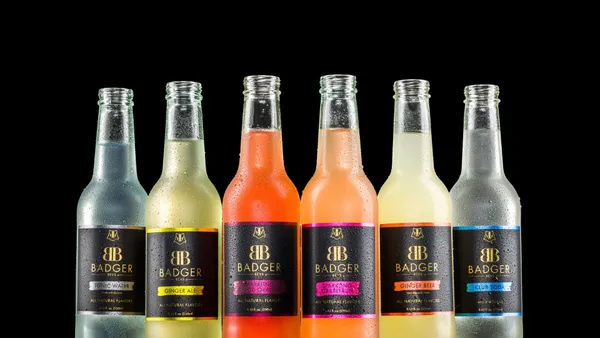Homemade cocktails are booming, with both legacy and recently launched brands competing for cash-strapped consumers. A new player in the mixers space is hoping to help consumers deliver a high-end bar experience from their kitchen.
Badger Bevs launched this spring with three premium mixers: Ginger Beer, Tonic Water, Club Soda, Sparkling Grapefruit, Sparkling Blood Orange and Ginger Ale. The brand is emphasizing its dedication to high quality ingredients compared to similar shelf-stable mixers on the market, designed to be paired with high quality spirits. It is available at small liquor stores and high end bars exclusively.
Boost Crop Yields and Cut Crop Losses with Visual AI for Precision Agriculture
Discover how artificial intelligence is helping farmers reduce crop loss and increase crop yields in real-time.
David Vogel, the company’s founder and CEO, brings over two decades of experience in the CPG space to Badger. He worked in several executive roles at Blue Buffalo pet food, which was acquired by food giant General Mills for $8 billion in 2018. Vogel also served as the executive vice president for marketing and sales at The Chef’s Warehouse. He said those experiences clued him in to where the food and beverage industry was headed — a move toward higher quality, premium ingredients.
Vogel said he identified there was an opening in the market for a premium cocktail mixer brand that is manufactured domestically.
“A lot of the competition comes from Europe. Living through the pandemic and seeing the supply chain get disrupted, I wanted to simplify the supply chain to enable our customers to get a better product made here,” Vogel said.

The mixologist stamp of approval
The mixers took several years to develop, during which Vogel enlisted established bartenders and mixologists to help perfect the brand’s formulas. Jillian Vose — a staple in the New York City bar scene, working at famous spots like Dead Rabbit, Death & Co. and Maison Premiere — joined the brand early in its development.
Vose said the resurgence of at-home bartending during the pandemic led to a boom of classic cocktails, as well as more adventurous options. There was a demand, she said, for high quality ingredients drinkers could use at home that were not wasteful.
“In a bar, making a big batch of a fruit cordial is one thing, but having to make it at home is quite time consuming, and you would not need to make as much,” Vose said. “These specialty mixers, especially with the flavors we’ve come out with, are a good enough quality that you would get at a really high end bar.”
Keep up with the story. Subscribe to the Food Dive free daily newsletterEmail:Sign up
Badger Bevs is competing with staples of the mixer space, including Q Mixers, Polar and Fever Tree, which each have national distribution models and have prioritized unique flavor launches in recent years. But unlike those brands, Badger is not interested in currently focused on expanding through mass distribution into major chain stores, only opting to be available at high end bars and at mom and pop liquor stores.
“We feel like it’s part of how we’re different and more specialized. A couple of good brands that have come before us have gotten so big and are everywhere. For us, being more local and specialized to fine dining is important,” Vogel said. “So if you go to Beef Bar in Tribeca or Principate in SoHo and you enjoy a great Badger cocktail, you can then decide to add it to your home bar.”
Badger, which is manufactured in Pennsylvania, initially launched in the Northeast and has since expanded to parts of the Midwest like Ohio and the Chicago metropolitan area. Vogel believes it can focus its resources in these areas and continue to expand West.
Two of the brand’s main distribution partners are Chef’s Warehouse, where Vogel previously worked, and LPG Family Distributors, one of the biggest liquor distributors in the country. The CEO believes these partners will best allow the brand to reach the at-home mixologist market it’s targeting.
According to Vogel, the brand is already planning on cocktail mixers it is launching next year, in order to stay ahead of the curve. Part of this means being meticulous about its innovation pipeline, making sure the taste profiles fit bartender-level quality.
Read More in Ingredients
Buckwheat in your ice cream? Quinoa in your milk? Sustainable grains emerge as a star ingredient
Ingredients in Focus: Maple water
Harken Sweets brings more superfood candy bars to the public in big retail push
How a Swedish company plans to dominate better-for-you snacking
RXBar founder ‘betting everything on protein’ with new venture
Ingredients in Focus: Hemp protein
Howtian debuts innovation in stevia sweetener market
Want to see more stories in Ingredients?
“That wasn’t until the 14th iteration of the Grapefruit that we were like ‘Ok, it has the right amount of extract and the right amount of juice, it tastes like a grapefruit, we’re happy now,’” Vogel said.


